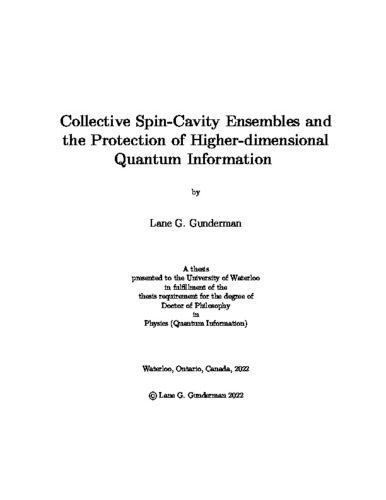| dc.description.abstract | The development of devices leveraging their quantum nature to outperform classical analogues has been an ongoing effort for many decades now. In this thesis we investigate two facets related to this effort, albeit at different potential timescales of utility.
First, we discuss our contributions in understanding collective spin ensembles interacting with a resonance cavity. This set up is common in superconducting qubit devices and electron spin-resonance experiments. The traditional model when considering this situation is the Tavis--Cummings model, although many of the methods could be adapted to other mesoscopic systems composed of ensembles of spins and cavities. In particular, we focus on characterizing the shifts in the energies due to dressing states, which are known as Lamb shifts. Before this line of work, most efforts focused on generating difference equations which could be solved iteratively to extract these shifts and dressed states. While this methodology works for systems involving hundreds of spins to thousands of spins, this iterative construction loses utility for larger ensembles due to the time needed to determine the parameters and prevents broad trends from being noted. Through these works we have stated how to determine the moments of the statistical distribution of the Lamb shifts, how to bound the largest of these shifts, and which of the subspaces are most important when finding these shifts. Beyond this, we have found that by including thermal effects we may use the moments of the Lamb shifts to greatly simplify a perturbative expansion to determine values of certain observables in optimal time (in spin ensemble size). These results provide greater insights into this model, provide faster simulation times, and can aide in experimental tests of these devices.
Second, we discuss the contributions made in quantum error-correcting codes. The typical formalism used for quantum error-correcting codes is the stabilizer formalism. In our work we have extended this formalism to no longer directly depend on the local-dimension of the quantum computing device. For instance, most devices being currently designed and built run on qubits, which have local-dimension two, while qutrits have local-dimension of three. By removing this local-dimensional dependency we are able to generate many stabilizer codes, including codes with parameters previously unknown--amongst which are local-dimension-invariant forms, with the same distance parameter value, for the Steane code, the entire quantum analog of the classical Hamming family, and the Toric code. While these codes do not outperform the best known codes, this serves as an interesting pedagogical and extended framework and may provide for improved codes upon sufficient consideration, or aide in other work in fields closely related to stabilizers. Meanwhile, this extended framework permits for the importation of quantum error-correcting codes from lower local-dimension values to devices with higher local-dimension values, which at least provides some code options if a quantum computer is developed with easily tuned local-dimension value.
These topics should be considered as disjoint, and all variable meanings are reset between the topics. | en |

